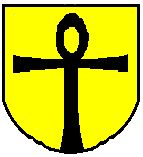Ankh
The Ankh is an ancient Egyptian hieroglyphic symbol that was most commonly used in writing and in art to represent the word for "life" and, by extension, as a symbol of life itself. The ankh has a cross shape but with a teardrop-shaped loop in place of an upper bar. The origins of the symbol are not fully known, but it is thought to represent the concept of eternal life, which is why it is often referred to as the "key of life" or the "cross of life".
Origins and Meaning[edit | edit source]
The exact origins of the Ankh are the subject of much debate among scholars. Some believe it may have originated from a sandal strap with the loop going around the ankle and the vertical part under the foot. Others see it as a symbol of the rising sun, with the loop representing the sun itself, and the vertical and horizontal lines representing its path. The ankh appears frequently in Egyptian art, especially in that of the Amarna period, where it is seen being offered to the pharaohs by the gods, particularly Amon-Ra, the god of the sun, symbolizing the "giving of life".
Symbolism and Use[edit | edit source]
The ankh symbolizes both mortal existence and the afterlife. In Egyptian tombs, the symbol was used to represent the life-giving air and water. It is often seen being carried by gods, pharaohs, and ordinary Egyptians. It was believed that the ankh's magical properties could be invoked for protection, especially for the dead, ensuring their immortality and safe passage into the afterlife. The ankh was also used as an amulet, either alone or in conjunction with two other hieroglyphs that mean "strength" and "health". Amulets were often made of gold, which was considered a divine and indestructible metal. The ankh amulet was worn for protection in life and placed among the wrappings of mummies to ensure the deceased a safe, healthy, and productive afterlife.
In Modern Times[edit | edit source]
Today, the ankh is an iconic symbol representing life, fertility, and the union of male and female. It has been adopted by various modern movements, including New Age spirituality and Afrocentrism, as a symbol of wisdom, insight, and a deep understanding of the nature of life. The ankh continues to be a popular symbol in jewelry and artwork, embodying a myriad of meanings, from personal growth and eternal life to the mystical union of opposites.
See Also[edit | edit source]
Search WikiMD
Ad.Tired of being Overweight? Try W8MD's physician weight loss program.
Semaglutide (Ozempic / Wegovy and Tirzepatide (Mounjaro / Zepbound) available.
Advertise on WikiMD
|
WikiMD's Wellness Encyclopedia |
| Let Food Be Thy Medicine Medicine Thy Food - Hippocrates |
Translate this page: - East Asian
中文,
日本,
한국어,
South Asian
हिन्दी,
தமிழ்,
తెలుగు,
Urdu,
ಕನ್ನಡ,
Southeast Asian
Indonesian,
Vietnamese,
Thai,
မြန်မာဘာသာ,
বাংলা
European
español,
Deutsch,
français,
Greek,
português do Brasil,
polski,
română,
русский,
Nederlands,
norsk,
svenska,
suomi,
Italian
Middle Eastern & African
عربى,
Turkish,
Persian,
Hebrew,
Afrikaans,
isiZulu,
Kiswahili,
Other
Bulgarian,
Hungarian,
Czech,
Swedish,
മലയാളം,
मराठी,
ਪੰਜਾਬੀ,
ગુજરાતી,
Portuguese,
Ukrainian
Medical Disclaimer: WikiMD is not a substitute for professional medical advice. The information on WikiMD is provided as an information resource only, may be incorrect, outdated or misleading, and is not to be used or relied on for any diagnostic or treatment purposes. Please consult your health care provider before making any healthcare decisions or for guidance about a specific medical condition. WikiMD expressly disclaims responsibility, and shall have no liability, for any damages, loss, injury, or liability whatsoever suffered as a result of your reliance on the information contained in this site. By visiting this site you agree to the foregoing terms and conditions, which may from time to time be changed or supplemented by WikiMD. If you do not agree to the foregoing terms and conditions, you should not enter or use this site. See full disclaimer.
Credits:Most images are courtesy of Wikimedia commons, and templates, categories Wikipedia, licensed under CC BY SA or similar.
Contributors: Prab R. Tumpati, MD












